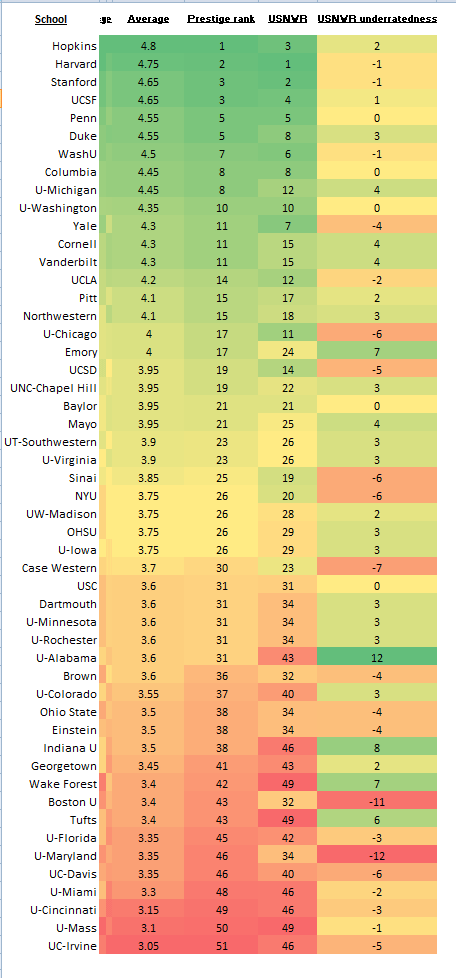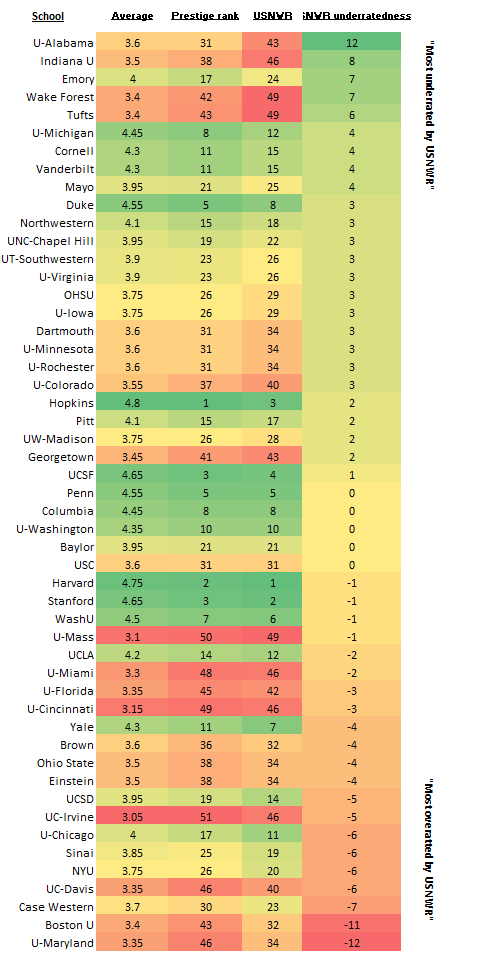- Joined
- Feb 26, 2014
- Messages
- 15
- Reaction score
- 42
One of the most popular topics on SDN is which schools are the "best." Applicants want to go to the best school, and that is why US News and World Report's (USNWR) rankings are so hotly discussed.
The problem is that USNWR tabulates its rankings based on criteria it chooses and weights, and these selections and weights are rather subjective. The USNWR uses:
40% - peer assessment (surveys are given to residency directors and peers, essentially)
30% - research (by NIH grant total and NIH per faculty)
20% - student selectivity
10% - faculty resources as measured by faculty-to-student ratio
The problem is that applicants are using USNWR rankings to assess which school is best for them to attend, even though the criteria do not necessarily match the quality of education a student receives at a given school. Nor does USNWR really tell you which school is best to ensure your success in matching to the residency of your choice.
Because I personally am deciding between a few schools, I thought about what matters to me, besides the intangibles like "student vibe," location, and cost. A big deciding factor for me is the extent to which the school is favored by residency directors and the deans and directors of admissions across the nation (i.e., "peers"). Of course, I also care about faculty resources and research, but to me these opportunities are pretty much available to students who seek it out.
I decided to average the residency and peer assessment ratings for the top-50 schools, with scores on a 1 to 5 scale, 5 being the most highly regarded. Then I ranked the average score to get a "pure prestige" ranking. Note that the rankings do not always match USNWR. Note I did not list the residency and peer rankings individually because they are exclusive-access data from USNWR, for which I have a subscription:

By subtracting the USNWR rankings from the prestige rankings, you can see which schools have the largest discrepancies between ranking systems. You could interpret that as most overrated and underrated. Note you could even argue my interpretation is actually reversed: That residency directors do not realize that the school does not deserve their reputation because, in reality, their research and faculty resources are less than they think.
Among top-25:

Among top-50:

The problem is that USNWR tabulates its rankings based on criteria it chooses and weights, and these selections and weights are rather subjective. The USNWR uses:
40% - peer assessment (surveys are given to residency directors and peers, essentially)
30% - research (by NIH grant total and NIH per faculty)
20% - student selectivity
10% - faculty resources as measured by faculty-to-student ratio
The problem is that applicants are using USNWR rankings to assess which school is best for them to attend, even though the criteria do not necessarily match the quality of education a student receives at a given school. Nor does USNWR really tell you which school is best to ensure your success in matching to the residency of your choice.
Because I personally am deciding between a few schools, I thought about what matters to me, besides the intangibles like "student vibe," location, and cost. A big deciding factor for me is the extent to which the school is favored by residency directors and the deans and directors of admissions across the nation (i.e., "peers"). Of course, I also care about faculty resources and research, but to me these opportunities are pretty much available to students who seek it out.
I decided to average the residency and peer assessment ratings for the top-50 schools, with scores on a 1 to 5 scale, 5 being the most highly regarded. Then I ranked the average score to get a "pure prestige" ranking. Note that the rankings do not always match USNWR. Note I did not list the residency and peer rankings individually because they are exclusive-access data from USNWR, for which I have a subscription:

By subtracting the USNWR rankings from the prestige rankings, you can see which schools have the largest discrepancies between ranking systems. You could interpret that as most overrated and underrated. Note you could even argue my interpretation is actually reversed: That residency directors do not realize that the school does not deserve their reputation because, in reality, their research and faculty resources are less than they think.
Among top-25:

Among top-50:



